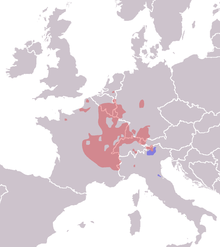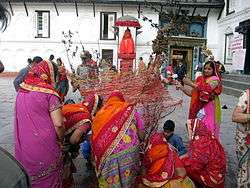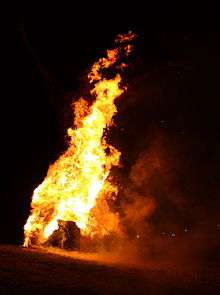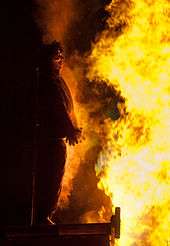Bonfire

A bonfire is a large but controlled outdoor fire, used either for informal disposal of burnable waste material or as part of a celebration.
Regional traditions
In many regions of continental Europe, bonfires are made traditionally on 16 January, the solemnity of John the Baptist, as well as on Saturday night before Easter. Bonfires are also a feature of Walpurgis Night in central and northern Europe, and the celebrations on the eve of St. John's Day in Spain. In Finland bonfires are tradition on Midsummer Eve and Easter, also in midst of May celebrations.
Alpine and Central Europe

Bonfire traditions of early spring, lit on the Sunday following Ash Wednesday (Funkensonntag), are widespread throughout the Alemannic German speaking regions of Europe and in parts of France. The burning of "winter in effigy" at the Sechseläuten in Zürich (introduced in 1902) is inspired by this Alemannic tradition. In Austria "Osterfeuer", Easter fires, are widespread, but also regulated in some cities, districts and countries to hold down the resulting annual peak of PM10-dust immission. There are also "Sonnwendfeuer" (solstice fires) ignited on the evening of 21 June.
Since 1988 "Feuer in den Alpen" (fires in the Alps) have been lit on a day in August on mountains so they can be seen from afar as an appeal for sustainable development of mountain regions.[1]
In the Czech Republic, the festival called "Burning the Witches" (also Philp & Jacob Night, Walpurgis Night or Beltane) takes place on the night between 30 April and 1 May. This is a very old and still observed folk custom and special holiday. On that night, people gather together, light bonfires, and celebrate the coming of spring. In many places people erect maypoles.
The night between 30 April and 1 May was considered magical. The festival was probably originally celebrated when the moon was full closest to the day exactly between the spring equinox and summer solstice. People believed that on this night witches fly on the Sabbath, and indeed this is one of the biggest pagan holidays. People also believed, for example, in the opening of various caves and underground caverns in which treasures are hidden. The main purpose of this old folk custom was probably a celebration of fertility.
To protect themselves against witches, people lit bonfires in high places, calling these fires "Burning the Witches". Some people took to jumping over the fire in order to ensure youth and fertility. The ash from these fires supposedly had a special power to raise crops, and people also walked the cattle through the ashes to ensure fertility.
Australia
In Australia, bonfires may be lit to celebrate Commonwealth Day or the Queen's Official Birthday.
Canada
Due to their historic connection to Britain the province of Newfoundland and Labrador have many communities that celebrate Bonfire night, this is one of the times when small rural communities come together. In the province of Quebec, many communities light up bonfires on 24 June to celebrate Saint-Jean-Baptiste Day.
India

In India, particularly in Punjab, people gather around a bonfire and eat peanuts and sweets during the festival of Lohri to celebrate the winter solstice which occurred during the Indian month of Magh. People have bonfires on communal land. If there has been a recent wedding or a new born in the family, people will have a bonfire outside their house to celebrate this event. The festival falls in the second week of January every year. In Assam in the northeastern part of India, a harvest festival called Bhogali Bihu is celebrated to mark the end of the harvest season in mid-January. In southern parts of India, particularly in Andhra Pradesh, Tamil Nadu and Mumbai, the Bhogi festival is celebrated on the last day of 'Maarkali', which is also the first day of the farmer festival Pongal. People collect unwanted items from their houses and set them on fire in a bonfire to celebrate. During the ten days of Vijayadashami, effigies of Ravana, his brother Kumbhakarna and son Meghanad are erected and burnt by enthusiastic youths at sunset.Traditionally a bonfire on the day of Holi marks the symbolic annihilation of Holika the demoness as described above.[2]
Iran
Chaharshanbe Suri is a fire jumping festival celebrated by Persian people, Kurdish people and some other people in the world. The event takes place on the eve of the last Wednesday before Nowruz. Loosely translated as Wednesday Light, from the word sur which means light in Persian, or more plausibly, consider sur to be a variant of sorkh (red) and take it to refer either to the fire itself or to the ruddiness (sorkhi), meaning good health or ripeness, supposedly obtained by jumping over it, is an ancient Iranian festival dating back to at least 1700 BCE of the early Zoroastrian era. Also called the Festival of Fire, it is a prelude to Nowruz, which marks the arrival of spring. The words Chahar Shanbeh mean Wednesday and Suri means red. Bonfires are lit to "keep the sun alive" until early morning. The celebration usually starts in the evening, with people making bonfires in the streets and jumping over them singing "zardi-ye man az toh, sorkhi-ye toh az man". The literal translation is, my yellow is yours, your red is mine. This is a purification rite. Loosely translated, this means you want the fire to take your pallor, sickness, and problems and in turn give you redness, warmth, and energy. There are Zoroastrian religious significance attached to Chahārshanbeh Suri and it serves as a cultural festival for Iranian and Iranic people.
Another tradition of this day is to make special Chaharshanbe Suri Ajil, or mixed nuts and berries. People wear disguises and go door to door knocking on doors as similar to Trick-or-treating. Receiving of the Ajeel is customary, as is receiving of a bucket of water.
Ancient Persians celebrated the last 5 days of the year in their annual obligation feast of all souls, Hamaspathmaedaya (Farvardigan or popularly Forodigan). They believed Faravahar, the guardian angels for humans and also the spirits of dead would come back for reunion. There are the seven Amesha Spenta, that are represented as the haft-sin (literally, seven S's). These spirits were entertained as honored guests in their old homes, and were bidden a formal ritual farewell at the dawn of the New Year. The festival also coincided with festivals celebrating the creation of fire and humans. In Sassanid period the festival was divided into two distinct pentads, known as the lesser and the greater Pentad, or Panji as it is called today. Gradually the belief developed that the 'Lesser Panji' belonged to the souls of children and those who died without sin, whereas 'Greater Panji' was truly for all souls.
Ireland
Throughout Ireland, bonfires are lit on the night of 31 October to celebrate Halloween[3] or Samhain. Bonfires are also held on 30 April, particularly in Limerick to celebrate the festival of Bealtaine and on St. John's eve, 23 June, to celebrate Midsummer's eve, particularly in County Cork where it is also known as 'Bonna Night'.[4]
Scotland

The annual rock and dance music Wickerman Festival takes place in Kirkcudbrightshire, Scotland. Its main feature is the burning of a large wooden effigy on the last night.[5] The Wickerman festival is inspired by the horror film The Wickerman, a film itself inspired by the Roman accounts of the Celtic Druids ritual burning of a wicker effigy.
Israel
In Israel, on the eve of Lag BaOmer, bonfires are lit on to commemorate the Mishnaic sage Rabbi Shimon Bar Yochai who according to tradition died on Lag BaOmer. Rabbi Shimon Bar Yochai is accredited with having composed the Kabalistic work The Zohar (literally "The Shining" - hence the custom of lighting fire to commemorate him). The main celebration takes place at Rabbi Shimon's tomb on Mt. Meron in northern Israel, but all over the country bonfires are lit in open spaces. Linked by Modern Jewish tradition to the Bar Kokhba Revolt against the Roman Empire (132-135 CE), Lag BaOmer is very popularly observed and celebrated as a symbol for the fighting Jewish spirit. As Lag Ba'Omer draws near, children begin collecting material for the bonfire: wood boards and planks, old doors, and anything else made of wood. On the night itself, families and friends gather round the fires and youths will burn their bonfires till daybreak.
Iraq
In Iraq bonfires lit to celebrate the Feast of the Cross by the Assyrian Christians. Beside the bonfire every household hang traditionally a lighted fire in the roof of their house.
Italy
In Northeast Italy, the celebration Panevin (in English "bread and wine") or Foghera or Pignarul is held in the evening of Epiphany's eve (5 January). A straw witch dressed with old clothes, is placed on a bonfire and burned to ash. The witch symbolizes the past and the direction of the smoke indicates whether the new year is going to be good or bad.
The Northern Italian La vecchia ("the old lady") is a version of the wicker man bonfire effigy, which is burned once a year as part of town festivals. As depicted in the film Amarcord by Federico Fellini, it has a more pagan-Christian connotation when it is burned on Mid-Lent Thursday.
In Southern Italy, traditionally bonfires are lit in the night between January 16th and 17th, thought to be the darkest and longest night of the year. The celebration is also linked to the cult of Saint Anthony The Great.
Japan
Every 16 August, the ancient city of Kyoto holds the Gozan no Okuribi, a Buddhist, bonfire based spectacle, which marks the end of the *O-Bon season.
Luxembourg
The Luxembourgish town of Remich annually holds a three-day-long celebration for Carnival (called Fuesend Karneval in Luxembourgish. The celebration of the Remich Fuesend Karneval celebrations concludes with the Buergbrennen, a bonfire that marks the end of winter. Such bonfires are also organised by others towns and villages throughout luxembourg around the same time, although they only last an evening.
Nordic Countries
In Iceland, bonfires are traditional on New Year's Eve, and on 6 January, which is the last day of the Icelandic Christmas season. In Norway and Denmark, large bonfires are lit on 23 June to celebrate "Jonsok" or "St Hansaften" the evening before John the Baptist's birthday. As many other traditions in Scandinavia, St. Hans is believed to have a pagan origin, the celebration of mid summer's eve. In Sweden Walpurgis Night is celebrated on 30 April which includes the burning of a bonfire. In Finland, Midsummer Eve is celebrated with large bonfires.[6]
Poland
.jpg)
In Poland, bonfires are traditionally and still enthusiastic burned during Feast of Saints Peter and Paul, Pentecost day and Saint John Night as Sobótki,[7] ognie świętojańskie[8](Śląsk, Małopolska, Podkarpacie), Palinocka (Warmia, Mazury, Kaszuby) or Noc Kupały (Mazowsze and Podlasie) on June 23/24. On 23 and 24 June, according to ancient custom, an immense number of Polish persons of both sexes repaired to the banks of the San (river), Vistula and Odra river, to consult Fate respecting their future fortunes, jumping through a fire on the Eve of Saint John's was a sure way to health. The leaping of the youths over fire (sobótka) must be a custom derived from remote antiquity. Jan Kochanowski, who died in 1584, mentions it in a song from an ancient tradition. Varro and Ovid relate, that in the Palilia, celebrated in honour of the goddess Pales, on 20 April, the anniversary of the foundation of Rome, the young Romans leaped over burning bundles of hay. In modern Italy, this kind of saltation is continued by the name of Sabatina,[9] though Pope Sergius III prohibited.
Lithuania
In Lithuania bonfires lit to celebrate St John's Eve (aka: Rasos (Dew Holiday). Bonfires may be lit to keep witches and evil spirit away.
Slavic Europe
In Bosnia and Herzegovina, Croatia, Serbia, Bulgaria and Slovenia, bonfires are traditionally lit on the evening before May 1, commemorating Labour Day.
In the Czech Republic and Slovakia, bonfires are also held on the last night of April and are called 'Phillip-Jakob's Night' or "Burning of the Witches". They are considered to be historically linked with Walpurgis Night and Beltane.
In Russia, bonfires are traditionally burned on November 17.
Romania
In Romania, in Argeș County, a bonfire is lit on the night of 25 Octomber every year, as a tradition said to be done since the Dacians. It consists in burning of a tall tree, which resembles the body of a god. It is usually done on a high peak, in order to be seen from far away.
Turkey
In Turkey bonfires lit on Hidirellez Day believed to be the awakening day of nature at the beginning of spring. Celebrated on 5 May.
United Kingdom

In the United Kingdom and some Commonwealth countries, bonfires are lit on Guy Fawkes Night[10] a yearly celebration held on the evening of 5 November to mark the failure of the Gunpowder Plot of 5 November 1605, in which a number of Catholic conspirators, including Guy Fawkes, attempted to destroy the House of Lords in London.
In Northern Ireland, bonfires are lit on Halloween, October 31.[11] and each 11 July, bonfires are lit by many Protestant communities to celebrate the victory of Williamite forces at the Battle of the Boyne,[12] which took place on 12 July 1690. This is often called the "Eleventh night". Bonfires have also been lit by Catholic communities on August 9 since 1972 to protest and commemorate Internment.[13]
United States

In New England, on the night before the Fourth of July, towns competed to build towering pyramids, assembled from hogsheads and barrels and casks. They were lit at nightfall, to usher in the celebration. The highest were in Salem, Massachusetts, composed of as many as forty tiers of barrels; these are the tallest bonfires ever recorded. The practice flourished in the nineteenth and twentieth centuries, and can still be found in some New England towns.[14]
On Christmas Eve in Southern Louisiana, bonfires are built along the Mississippi River levees to light the way for Papa Noël as he moves along the river in his pirogue (Cajun canoe) pulled by eight alligators. This tradition is an annual event in St. James Parish, Louisiana.[15]
Farm and garden bonfires
Bonfires are used on farms, in large gardens and allotments to dispose of waste plant material that is not readily composted. This includes woody material, pernicious weeds, diseased material and material treated with persistent pesticides and herbicides. Such bonfires may be quite small but are often designed to burn slowly for several days so that wet and green material may be reduced to ash by frequently turning the unburnt material into the centre. Such bonfires can also deal with turf and other earthy material. The ash from garden bonfires is a useful source of potash and may be beneficial in improving the soil structure of some soils although such fires must be managed with safety in mind.[16] Garden and farm bonfires are frequently smoky and can cause local nuisance if poorly managed or lit in unsuitable weather conditions.[17]
See also
| Wikimedia Commons has media related to Bonfire. |
- Aggie Bonfire; includes 1999 disaster that killed 12 people when it collapsed during construction
- Bonfire Rally
- Easter Fire
- Bonfires of Saint John
- Burning Man
- Effigy
- Fire ritual
- Fireworks
- Gozan no Okuribi
- Holi
- Marzanna
- Need-fire
- Piano burning
- Sussex Bonfire Societies
- Wicker man
References
- ↑ Organizers of "Feuer in den Alpen", see: "Hintergründe"
- ↑ Origins of Holi BBC.
- ↑ Council faces €1m clean-up bill after Halloween horror Irish Independent
- ↑ City Local - Cork
- ↑ Gallery, Thewickermanfestival.co.uk
- ↑ Dunford, George (15 June 2011). "Finland's Midsummer Madness". LonelyPlanet.com. BBC Worldwide. Retrieved 23 June 2011.
- ↑ "sobótka ognisko palone w wigilie św. Jana, przy którym odbywały się obrzędy i zabawy związane z odejściem wiosny i nadejściem lata, kontynuacja pogańskiego zwyczaju ludowego. " in: Marian Kucała. Słownik polszczyzny Jana Kochanowskiego. 1994 s. 560
- ↑ "In the south of Poland, from the Silesian frontier as far as the bend of the San river including the districts of mountains and foothills, Whitsun and Saint John's fires were customary. In the low country both kinds of annual fires were called sobótki; in the mountains term like ognie, fakty, składanie watry, and palenie watry were usedes sobótki." in: Zeitschrift für Ostforschung, t. 22, Johann Gottfried Herder-Forschungsrat. wyd. 1, 1973, str. 115
- ↑ "Włochy mają Sobótki pod imieniem Sabatina; znane są i w Niemczech." in: Oskar Kolberg. Dzieła wszystkie: Mazowsze.; "sobótka, ital. sabatina, cat. coena sabbathina" in: Samuel Bogumił Linde. Słownik języka polskiego R-T ;
- ↑ "Guy Fawkes Night". Bonfirenight.net. 2008-04-13. Retrieved 2010-09-13.
- ↑ Halloween fire calls 'every 90 seconds' UTV News
- ↑
- ↑ "Internment Bonfires". 2012-08-09.
- ↑ "The Night Before the Fourth". The Atlantic. 1 July 2011. Retrieved 4 November 2011.
- ↑ Stjamesparish.com
- ↑ "Bonfire safety". Safegardening.co.uk. 2007-10-29. Retrieved 2010-09-13.
- ↑ "What's wrong with Bonfires?". Environmental-protection.org.uk. Retrieved 2010-09-13.
